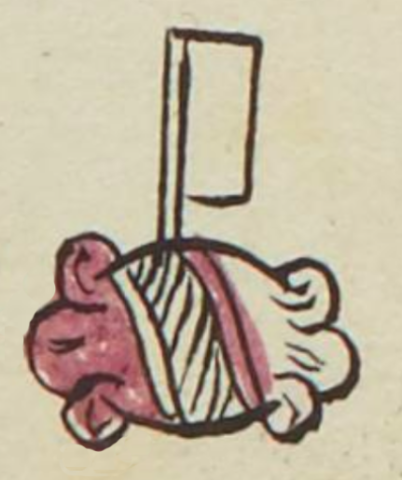Tepan (MH520r)
This compound glyph for the personal name Tepan (perhaps "On Someone") shows a horizontal stone, with its hallmark curling ends and diagonal stripes, and a rectangular, vertical banner on a stick coming up from the rock. The banner is white. The stone is half red (or a dark pink). The stripe in the middle of the stone has diagonal hash marks across it.
Stephanie Wood
Here, Tepan suggests a reading of Stone-Banner, but this could be a rebus for wall or boundary (tepantli). It can also mean "On Someone." Tepan onoc refers to someone who is "infamous," but literally means to lie down on someone, and may refer to male homosexuality. See our entry for the name Tepanonoc.
Tepan is a Nahua personal name, preceded in the gloss by a Christian first name (Toribio). He may have been named after Toribio de Benavente, also known as Motolinia ("One Who is Poor or Afflicted"). This was the first word he learned in Nahuatl, and he went on to learn the language well. He lived in the monastery in Huejotzingo. Doing a quick search for the name "Toribio" will produce an impressive result.
Stephanie Wood
torio tepā
Toribio Tepan
Stephanie Wood
1560
Stephanie Wood
flags, banners, banderas, piedras, muros, cercas, linderos

te(tl), stone, https://nahuatl.wired-humanities.org/content/tetl
pan(itl), flag/banner, https://nahuatl.wired-humanities.org/content/panitl
-pan, in or on, https://nahuatl.wired-humanities.org/content/pan
tepan(tli), wall/fence or boundary, https://nahuatl.wired-humanities.org/content/tepantli
tepan, on someone, https://nahuatl.wired-humanities.org/content/tepan
tepan onoc, an infamous person, https://nahuatl.wired-humanities.org/content/tepan-onoc
onoc, lying down or stretched out, https://nahuatl.wired-humanities.org/content/onoc
Piedra-Bandera, o El Lindero, o El Muro
Stephanie Wood
Matrícula de Huexotzinco, folio 520r, World Digital Library.
https://www.loc.gov/resource/gdcwdl.wdl_15282/?sp=119&st=image.
This manuscript is hosted by the Library of Congress and the World Digital Library; used here with the Creative Commons, “Attribution-NonCommercial-ShareAlike 3.0 License” (CC-BY-NC-SAq 3.0).








